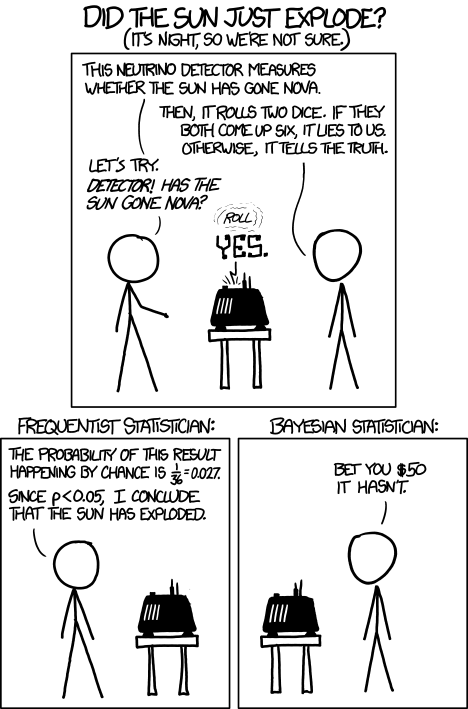“You should know that 9 out of 10 people who undergo this surgery will die. But don’t worry, the last 9 people who took this surgery all died, so you’re in the clear!”
😱😱😱
Technically 1 out of 1 people who undergo that procedure die, eventually. Same is true for people who elect not to have the procedure done, eventually.
That’s not confirmed. Only about 93% of people who ever lived died so far.
Death rate is also strongly correlated with when you were born. We’ve gotten much better at not being dead in the last 100 years. For people born in 1924 the death rate is nearly 100%, but for people born in 2024 it has dropped close to zero!
Being alive has both a 100% morbidity rate and a 100% mortality rate.
The Main cause of divorces are marriages.
deleted by creator
Doctor stabs you. “Oh no! Questioning the surgery claims another…”
Is the surgery incredibly risky overall but the surgeon only takes patients with the highest chances of survival?
If you were the patient, you’d still be happy about that. If the surgeon is cheating the stats, but has already accepted you as a patient, then you have the highest chance of survival.
Great point, you’re right!
Irrelevant, still good news if he’s gonna be operating on me!
I mean even then the stats can change with so many variables. It’s kind of like how you have a 50% chance of surviving by splitting up with Sam. You both knew it had to be done- the forest was thick and you knew it could only stalk one of you. You wish you had more time with him, but someone had to survive to tell the tale.
As you get some distance and pray to God that you are alone, you crouch low and look for any sign of a trail or a building to get to. The fog is beginning to thicken as you decide to move downhill. Water flows downward, so this is the best chance you have to find a river.
You keep running as quietly as you can as the last glow of sunlight dissipates from above the trees. You begin to panic as you realize there’s no hope for navigation in pure darkness. But then hope. The bubbling of water on rocks tells you that the river is just below. You cautiously move through the brush, heart pumping- were you being followed? It could have been waiting for the perfect moment- who knows how quietly it can move.
You get down to the river when you see a light on the other side. You focus on the shining and see it’s a flashlight. Sam had taken the flashlight with him, is it possible your paths reconnected? You wade across the shallow current- the water is cold but maybe this means you two lost whatever it was miles ago. Your shoes press down on the pebble shores as you scrape your way up the bank. “SAM” you whisper “SAM HEY”. No response. You slow down as you approach the flashlight laying on the ground. It was Sam’s, but Sam was nowhere to be seen. You reach down as you feel rain drops slowly fall on you. As you grab the light you notice something- the raindrop on your hand is dark.
As you realize what you are seeing, you begin to shake, mouth agape. You feel another drop on your shoulder. You knew you shouldn’t. You knew you should have accepted it and just moved on. You shouldn’t have looked up.
There he was. The top half of Sam was dangling from the branches, his pale face looking down at you with blood streaking across his face and dripping off his nose. How could this happen? What could do this to Sam, especially since you knew he was the fastest man in your platoon. He was able to get to you with the ammunition you needed when you’re whole unit was under fire in Kuwait. He saved your life, but you couldn’t do the same for him.
The shock is broken when you hear heavy boots stepping in front of you. It was over. There was nothing you could do. Nothing you ever could do. It- he- whatever you would call the figure in front of you just stated back into your soul. You felt the rattling of your lungs as you took the last few breaths you ever would. The blood soaked hands that reached out through the darkness led up to the man of your nightmares. Bits of Sam falling out of his mouth, he is fully revealed. It was him. It was always him. It was always
Tap for spoiler
But yea in order to answer this we should define our parameters a bit more.
I’m so glad I decided to read this without skipping to the end first. What a great little journey, thanks for this.
My only suggestion is to spoiler the last bit for those with wandering eyes.
Good idea! Thanks!
How would you scientifically measure a difference between those two definitions?
I mean, say this doctor has a 100% success rate but another doctor has 0%. Those two doctors collectively have a 50% success rate but it you have far better odds with the first doctor than the second
The two doctors would only have a combined 50% success rate if they perform the same number of surgeries
After a certain point, it’s really society’s fault for letting the surgeon batting 0 continue performing surgeries.
That surgeon is bound to get one right one of these days!
It’s just statistics.
@Cenotaph Nope, say the first doctor did 100 successful cases, the other did 2 successful and 2 failed, then the collective would be (100+2)*100/104 = 98.07%
So the number of cases would matter.
Of course. My point was only that there is definitely a difference between an individual doctor’s success rate and the overall success rate of a procedure across all doctors, responding to the commment I replied to.
98.07 for the surgery in general but not if you have decided to go to the first doctor. Then the 50% chance of the second doctor doesn’t not come into the equation, assuming surgery is done by the first doctor who is independent of second doctor. Hope that makes more sense.
In a statistical regression model, that would be a variable that encodes a specific individual; although encoding hypothetical (the scientific meaning of that word, not the layperson meaning) attributes of that individual is probably functionally equivalent, more useful, and easier to conduct.
Attributes of the surgeons is not easier, because you need to pick the correct attributes.
Really you just need an indicator variable showing 1 if its data from the surgeon under analysis and zero otherwise.
Then test for that indicator variable being statistically larger than 0.
So…
- normal people are scared because they fall for the gambler’s fallacy,
- mathematician is feeling fine because a 50% chance is a 50% chance,
- and the scientist is feeling extra fine because the experimental data shows that the surgery is actually safer than 50%
Did I get it right?
Depending on what you’re treating, 50% sounds pretty good.
I remember when I went for my last surgery and I was signing all the consent forms, my doctor was emphasising the 17% chance of this known lifelong complication, and the increased 4% chance of general anaesthesia fatality (compared to 1 in 10,000 for general public).
My mum was freaking out because when she had the same surgery she’d been seen much earlier in the disease process, she wasn’t expecting such a “high” risk of complications in my care.
But all I was hearing is that there’s an over 80% chance it will be a success. Considering how limited and painful my life was by the thing we were treating, it was all no brainier, I liked those odds. Plus my condition is diagnosed 1 in 100,000 people, so how much data could my surgeon really have on the rate of risk, the sample size would be laughable.
Still the best decision of my life, my surgeon rolled his skilled dice, I had zero complications (other than slow wound healing but we expected and prepared for that). I threw my crutches in the trash 2 years later, and ran for the first time in my life at 27 years old after being told at 6 years old that I’d be a full time wheelchair user by 30.
That’s awesome. I’m glad everything went so well. Here’s to a healthy and long life! Even the idea of going under is terrifying to me. You definitely had some courage with that attitude and that’s really admirable.
It helps that I’d had several previous surgeries, so I’d had practice at keeping my cool. Plus my surgeon was in discussion with me for months with multiple consultations to really understand the issue, I don’t think I could have possibly been in safer hands.
the gambler’s fallacy is the opposite of what applies to #1
“is the belief that, if an event (whose occurrences are independent and identically distributed) has occurred less frequently than expected, it is more likely to happen again in the future (or vice versa).” -per wikipedia
#2 is an optimist? A glass half full type of guy maybe.
#3 i’d guess is inferring that the statistics are based on an even distribution where the failures are disproportionately made up of by the same select few surgeons. or maybe that’s #2 and the scientist actually know the theory of how the procedure works in addition to what #2 knows about statistics and distributions.
1 in 100,000 not 10,000 (anaesthesia deaths)
Well either it’s 1 in 10,0000 in my country, or the department of health, my surgeon and GP are all missing a zero… which isn’t more likely because there’s no way our risk would be that much higher than the UK, and the NHS public health resources is 100,000.
I can’t load that page so assuming it just says 1 in 10,000. That does seem like an insane difference and actually quite a high risk imo given how many people undergo surgery.
10 points to Gryffindor
Yay!
The mathematician is probably feeling fine because he is computing the conditional probability of survival (otherwise fuck no I am not taking a surgery that has a %50 chance of killing me, that is way too much).
deleted by creator
deleted by creator
deleted by creator
deleted by creator
deleted by creator
Gamblers fallacy does go both ways. There’s also a thing in gambling, not part of the gamblers fallacy, more of a superstition thing, that there can be runs of, what is more or less luck. The gamblers fallacy would have you believe that after 20 successes, a failure is “due to happen”. According to math, that’s not the case, and in the event of something that requires skill to execute, almost nothing is just luck or statistics.
So the last one isn’t so much the gamblers fallacy, if anything it would be the superstition that the run of successes will continue; however scientists will look at this more as a game of skill. While 50% of all patients who have the procedure do not survive, or whatever, the last 20 of this doctors patients have survived. Clearly their skill for the procedure is above average. Even from a statistics perspective the rate might be 50% but you’re in the hands of a doctor pushing that number up to 50%, rather than dragging it down to 50%. So on all fronts, if you hear this, bluntly, you have an unknown risk level, somewhere between 50% and 0%.

Gamblers fallacy or law of large numbers…
law of large numbers does not imply gambler’s fallacy
First 20 patients died until the surgeon learned how to do it, next 20 survived. Technically it’s 50% survival rate
Depends on the sample size.
If it’s just this guy doing it, then yeah.
If it’s this guy who has done the procedure 20 times with 20 successes, and another doctor who sucks, who performed the procedure 20 times with 20 fatalities, that’s different.
It’s likely that the sample size is much larger than one or two doctors.
Yeah that’s how “normal people” thinks here
Can somebody explain the difference between the mathematician and the scientist parts of this?
The normal person thinks that because the last 20 people survived, the next patient is very likely to die.
The mathematician considers that the probability of success for each surgery is independent, so in the mathematician’s eyes the next patient has a 50% chance of survival.
The scientist thinks that the statistic is probably gathered across a large number of different hospitals. They see that this particular surgeon has an unusually high success rate, so they conclude that their own surgery has a >50% chance of success.
Thanks. I suspect a mathematician would consider the latter point too though.
Removed by mod
And me mate paul
My aunt Nancy would surely be in the 50% who die
Would be or do you want her to be? Sound like aunt Nancy isn’t very nice.
The popularity of casinos and lotteries say otherwise.
Someone who goes to casinos would come to the same conclusion, thinking that the surgeon is ‘running hot’.
Anyone with a good high school education should understand this.
That’s sort of why I asked. I thought I was missing something but no, the meme is apparently assuming academic professionals are dummies. Not to say that we should expect nuance and robust portrayals from a meme.
deleted by creator
Or do think there’s something special about the person that makes them flip tails more often?
Yes, that’s the conclusion that the scientist has come to. The chance of getting 20 in a row is so extraordinarily unlikely that it’s reasonable to conclude that the chance is not 50/50 for that particular surgeon.
deleted by creator
Mathematician sees each individual outcome as independent 50% chance.
Scientist realises that the distribution of failures and successes puts him in a favorable position. e.g. for the 20 in a row to be a success in a 50% fail rate that means the previous 20 were all failures or some similar circumstances where the success rate rose over time or similar polarization of outcomes in the sample data which places them above average odds.
Assuming X~B(20,0.5), that gives us a p-value of…
0.00000095367431640625
Time to reject H0!
You’re assuming those 20 were the only ones. Zoom out.
I was thinking more a binomial proportion test with the available data ;)
Also, yep, “assuming” was a key part of the statement!
Plot twist: 50% of each individual patient survives. Hope you get lucky with which organs make it
The left 50% or the right 50%
Bottom 50%
yes
So mathematicians and scientists cannot be normal people?
no.
No, never.
That’s mean
That’s median
That’s mode
That’s standard deviation
Until vastly larger numbers of people get trained in Advanced Mathematics and Degree Level Scientific disciplines, the human norm will never be anywhere near Mathematicians and Scientists.
It’s quite literally abnormal to be a Scientist or Mathematician.
Then again, so is being Homeless or an Olympic-level Athlete.
Being taught Statistics at University was a real eye opener on this…
…How much is the total amount?
WIth or without tax?











